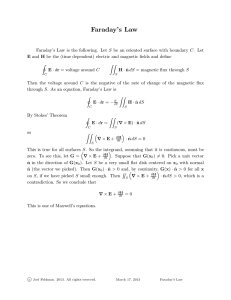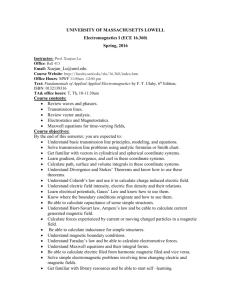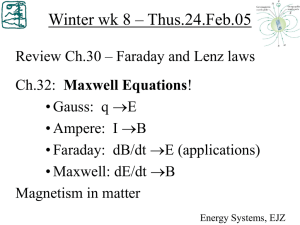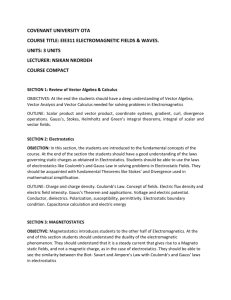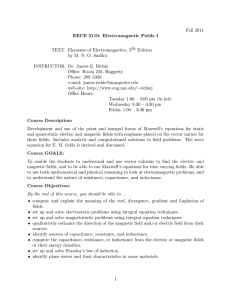Evolution of Electromagnetics in the 19th Century
advertisement
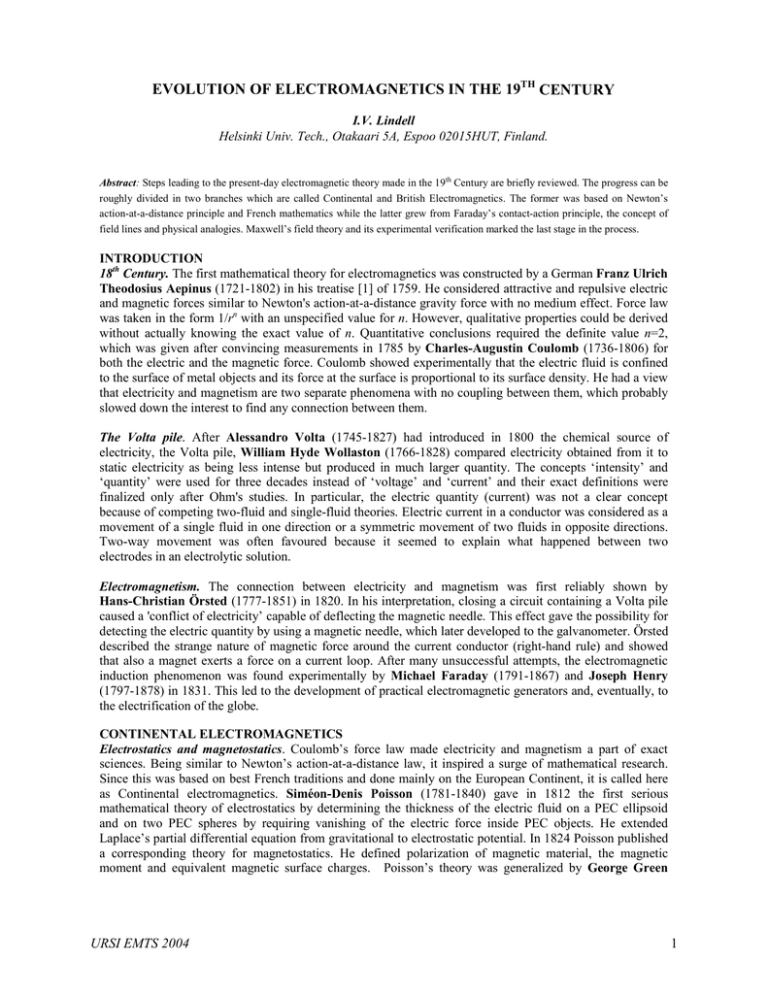
EVOLUTION OF ELECTROMAGNETICS IN THE 19TH CENTURY I.V. Lindell Helsinki Univ. Tech., Otakaari 5A, Espoo 02015HUT, Finland. Abstract: Steps leading to the present-day electromagnetic theory made in the 19th Century are briefly reviewed. The progress can be roughly divided in two branches which are called Continental and British Electromagnetics. The former was based on Newton’s action-at-a-distance principle and French mathematics while the latter grew from Faraday’s contact-action principle, the concept of field lines and physical analogies. Maxwell’s field theory and its experimental verification marked the last stage in the process. INTRODUCTION 18th Century. The first mathematical theory for electromagnetics was constructed by a German Franz Ulrich Theodosius Aepinus (1721-1802) in his treatise [1] of 1759. He considered attractive and repulsive electric and magnetic forces similar to Newton's action-at-a-distance gravity force with no medium effect. Force law was taken in the form 1/rn with an unspecified value for n. However, qualitative properties could be derived without actually knowing the exact value of n. Quantitative conclusions required the definite value n=2, which was given after convincing measurements in 1785 by Charles-Augustin Coulomb (1736-1806) for both the electric and the magnetic force. Coulomb showed experimentally that the electric fluid is confined to the surface of metal objects and its force at the surface is proportional to its surface density. He had a view that electricity and magnetism are two separate phenomena with no coupling between them, which probably slowed down the interest to find any connection between them. The Volta pile. After Alessandro Volta (1745-1827) had introduced in 1800 the chemical source of electricity, the Volta pile, William Hyde Wollaston (1766-1828) compared electricity obtained from it to static electricity as being less intense but produced in much larger quantity. The concepts ‘intensity’ and ‘quantity’ were used for three decades instead of ‘voltage’ and ‘current’ and their exact definitions were finalized only after Ohm's studies. In particular, the electric quantity (current) was not a clear concept because of competing two-fluid and single-fluid theories. Electric current in a conductor was considered as a movement of a single fluid in one direction or a symmetric movement of two fluids in opposite directions. Two-way movement was often favoured because it seemed to explain what happened between two electrodes in an electrolytic solution. Electromagnetism. The connection between electricity and magnetism was first reliably shown by Hans-Christian Örsted (1777-1851) in 1820. In his interpretation, closing a circuit containing a Volta pile caused a 'conflict of electricity’ capable of deflecting the magnetic needle. This effect gave the possibility for detecting the electric quantity by using a magnetic needle, which later developed to the galvanometer. Örsted described the strange nature of magnetic force around the current conductor (right-hand rule) and showed that also a magnet exerts a force on a current loop. After many unsuccessful attempts, the electromagnetic induction phenomenon was found experimentally by Michael Faraday (1791-1867) and Joseph Henry (1797-1878) in 1831. This led to the development of practical electromagnetic generators and, eventually, to the electrification of the globe. CONTINENTAL ELECTROMAGNETICS Electrostatics and magnetostatics. Coulomb’s force law made electricity and magnetism a part of exact sciences. Being similar to Newton’s action-at-a-distance law, it inspired a surge of mathematical research. Since this was based on best French traditions and done mainly on the European Continent, it is called here as Continental electromagnetics. Siméon-Denis Poisson (1781-1840) gave in 1812 the first serious mathematical theory of electrostatics by determining the thickness of the electric fluid on a PEC ellipsoid and on two PEC spheres by requiring vanishing of the electric force inside PEC objects. He extended Laplace’s partial differential equation from gravitational to electrostatic potential. In 1824 Poisson published a corresponding theory for magnetostatics. He defined polarization of magnetic material, the magnetic moment and equivalent magnetic surface charges. Poisson’s theory was generalized by George Green URSI EMTS 2004 1 (1793-1841) in a privately published article in 1828, which introduced the Green function and Green’s theorem. The article, however, went unnoticed during his lifetime. Ampère’s force law. After Örsted’s discovery, André-Marie Ampère (1775-1836) demonstrated in 1820 that there is a force between parallel currents. In 1826 he formulated the basic law for the force between two differential current elements [2]. The law obeyed Newton’s principle of action and reaction. It was later replaced by other versions, the most familiar version being the one formulated in 1845 by Hermann Grassmann (1809-1872), which is today found in basic textbooks. These two laws are still being disputed of their validity because, although they give the same result for the total force between two closed current loops, the distribution of the force along the loops is different [3]. Ohm’s law. After the introduction of the Volta pile, it took three decades before finally understanding what happened in the circuit connecting the poles. This was mainly because of the instability of the early chemical elements but also due to uncertainty about single-fluid and two-fluid theories. Finally, Georg Simon Ohm (1787-1854) published a book in 1827 where the electric current was considered similar to flow of heat. Propagation of heat in a conducting medium had been mathematically analyzed in 1822 by Joseph Fourier (1763-1830) in a revolutionary book [5] applying partial differential equations and boundary conditions. Ohm related the flow of electricity in a conducting medium to the drop of electroscopic force (potential) whose counterpart is the gradual drop of temperature in a medium for a difference in temperatures at the boundaries. Weber’s force law. Faraday’s induction experiment was expressed mathematically in 1845 by Franz Neumann (1798-1865) in terms of a simple quantity known as the vector potential. This expression, which gives the electromotive force induced in a loop by a changing magnetic field, is known as Faraday’s law. In 1846 Wilhelm Weber (1804-1891) was able to unify Coulomb’s, Ampère’s and Faraday’s laws into a single force law. Basically, this was Coulomb’s law generalized to two moving point charges and called Weber’s force law. To produce Ampère’s law, electric currents must be assumed in the form of positive and negative charges moving symmetrically in opposite directions. Faraday’s law follows from Ampère’s law and energy conservation, as was shown by Helmholtz [6]. The form of Weber’s force law was more general than Newton’s because of its dependence on the first and second time derivatives of the distance between the charges. The critique on a failure in energy conservation was proved groundless when Weber derived a generalization of Coulomb’s potential function producing the force law. Weber’s law gave an instantaneous action-at-a-distance formulation to the basic electromagnetic force and represented the high point of Continental electromagnetics. Retardation due to finite velocity was introduced to the force law In 1858 by Bernhard Riemann (1826-1866) and in 1867 by Ludwig Lorenz (1829-1891). However, in between Maxwell’s theory had already been published. BRITISH ELECTROMAGNETICS Faraday’s field concept. The British branch of electromagnetics started by Faraday’s induction experiment. He explained it in terms of magnetic lines or tubes of force whose changes in a conducting loop would induce an electromotive force. Magnetic lines were suggested to him by figures made by iron filings. Because such lines connect magnetic poles of opposite polarity, they appeared to convey the attractive force like rubber strings. On the other hand, adjacent lines ending to magnetic poles of the same polarity act as tubes under pressure tending to repel each other laterally. Similar force lines were later suggested to the electric force. This kind of physical imagery guided Faraday and his British followers forward. A crucial discovery was made in 1845 when Faraday found that magnetic field affects the polarization of light passing through certain media in the direction parallel to the field, known today as Faraday rotation. This gave him a reason to speculate about light being some kind of oscillatory wave propagating along magnetic field lines. Thomson’s analogies. William Thomson (Kelvin) (1824-1907) had read Fourier’s book when entering the University of Cambridge in 1840. He wrote a paper where showing that Fourier’s stationary flow of heat was mathematically analogous to Coulomb’s force law even if the former applied contiguous transfer of heat and the latter action over a distance. The lines of heat flow followed exactly Faraday’s electric lines of force. This gave Thomson the idea to represent the electric field in terms of a flux of electricity starting from the 2 URSI EMTS 2004 charge point. Another set of analogies was found between electrostatic polarization in insulating media and displacements in elastic solids due to stress. In 1856 he tried to explain the Faraday rotation phenomenon in terms of molecular vortices caused by the magnetic field. Maxwell’s field theory. Thomson’s application of analogies found an eager follower in James Clerk Maxwell (1831-1879). In an 1856 article he worked with the analogy of hydrodynamics dealing with an incompressible and massless fluid. Maxwell separated between physical quantities of two kinds, ‘intensity’ like the gradient of the pressure and ‘quantity’ like the velocity. They obeyed a linear relation involving a parameter of the medium. Thus, for magnetism (electricity) the intensity was denoted by H (E) and quantity by B (D) and their relation by m (e). Applying Stokes’ and Gauss’ integral theorems Maxwell could express all known basic electromagnetic laws in terms of differential divergence and curl operations (in component form), each related to some analogy in hydrodynamics. After this, in 1861-1862, he constructed a single mechanical model to represent the interactions of all electromagnetic phenomena. The starting point was Thomson’s idea of relating the magnetic field and rotating medium. Maxwell interpreted the magnetic intensity H as the angular velocity of a vortex of physical fluid whose mass corresponded to the magnetic permeability. Separating the vortices by bearing balls, which corresponded to electric charges and conveyed the rotating motion between vortices, he could imitate Ampère’s and Faraday’s laws in curl equation form. In its first form, the model resembled a clockwork where the motion was simultaneous over the whole space. Because it did not yet explain the electrostatic polarization, Maxwell decided to improve the model by adding elasticity to the fluid vortices which corresponded to adding a displacement current term to the existing equations. This made a dramatical change to the stiff clockwork which now started to resemble jelly. In fact, motions were no longer felt simultaneously but they propagated through the structure in wavelike manner. Computing the velocity of the electromagnetic wave, Maxwell got a result, which was close to the velocity of light known from earlier measurements. This finally unified electromagnetics and light. The final touch. Maxwell’s final formulation in his book [8] involved 20 scalar equations with as many unknowns, which was too complicated for most of his contemporary physicists to grasp. The Maxwell equations we know today in vector form are due to Oliver Heaviside (1850-1925) from 1886 [9] as what he called ‘the duplex method’. Heinrich Hertz (1857-1894) also simplified Maxwell’s formulation after experimentally verifying their prediction of wavelike propagation. CONCLUSION Evolution of electromagnetics from the Stone age of Coulomb’s law to the Modern times of Maxwell’s equations took place during the 19th Century. Two main branches could be identified, labeled here as Continental and British electromagnetics. The former had its high point in Weber’s force law which unified Coulomb’s, Ampère’s and Faraday’s laws in one neat expression. However, on the British side, Maxwell was able to add one new term to the existing equations which made a revolutionary difference. REFERENCES [1] Aepinus, F.U.T., Tentamen Theoriae Electricitatis et Magnetismi, St Petersburg, 1759. Translation, R.W. Home, P.J. Connor, Aepinus's Essay on the Theory of Electricity and Magnetism, Princeton University Press, Princeton NJ, 1979. [2] Ampère, A.M., Théorie mathématique des phénomènes électro-dynamiques uniquement déduite de l'expérience, Chez Firmin Didot, Paris, 1826; reprint Jacques Gabay, Paris, 1990. [3] Assis, A.K.T., Weber's Electrodynamics, Kluwer, Dordrecht, 1994. [4] Ohm, G.S., Galvanic Circuit Investigated Mathematically, Van Nostrand, New York, 2002. Translation of the 1827 German original. [5] Fourier, J., Théorie de la chaleur, Jacques Gabay, Paris, 1988, reprint of the 1822 original. [6] Helmholtz, H. von, Über die Erhaltung der Kraft, Verlag G. Reimer, Berlin, 1847. [7] Darrigol, O., Electrodynamics from Ampère to Einstein, Oxford University Press, New York, 2000. [8] Maxwell, J.C., Treatise on Electricity and Magnetism, Vol.2, 3rd ed., Clarendon Press, Oxford, 1904, pp.480-493. [9] Heaviside, O., Electrical Papers, Chelsea, New York, 1970, Vol.1 p.447, Vol.2 pp.172-175. Reprint of the 1st ed., London 1892. URSI EMTS 2004 3
